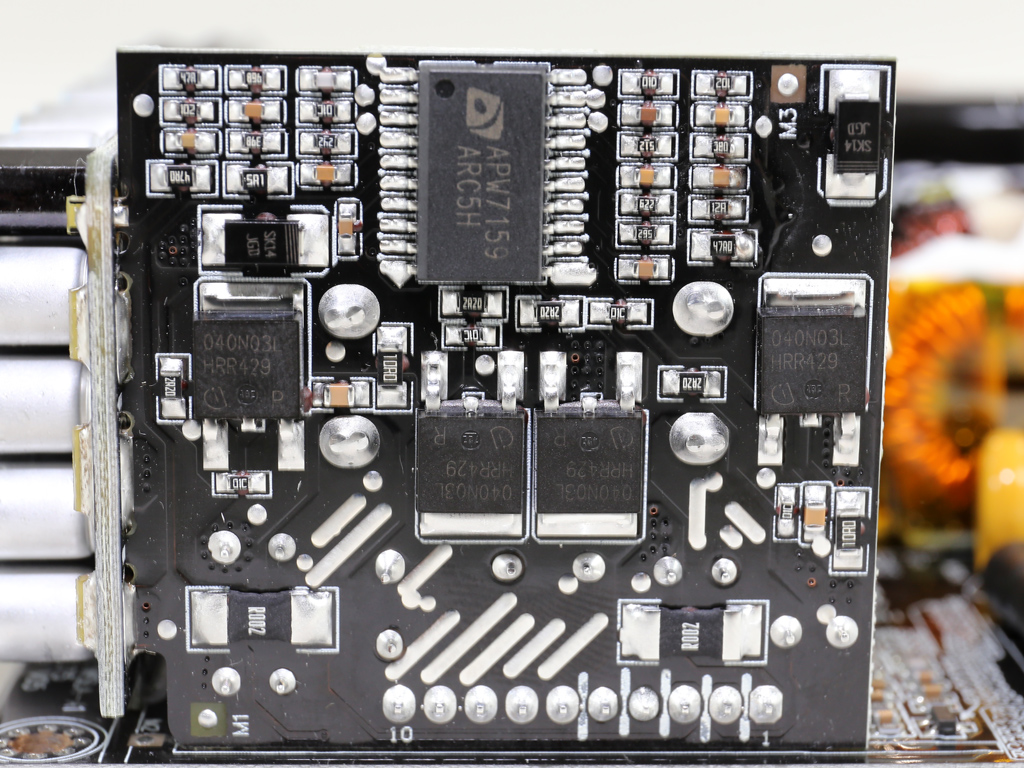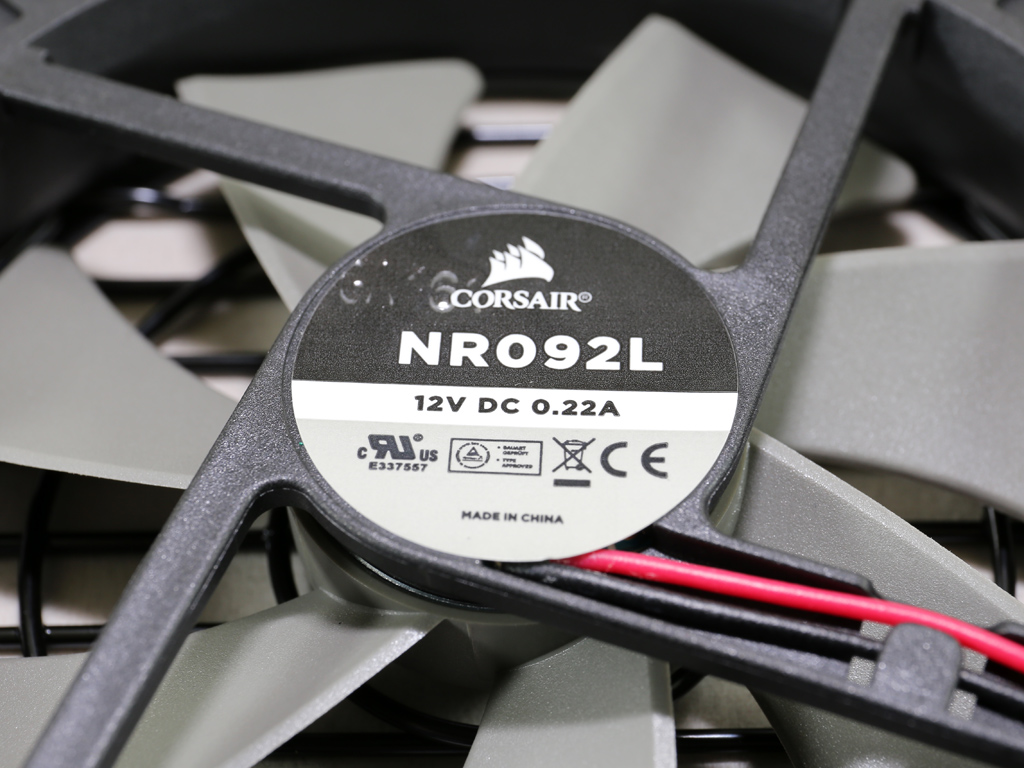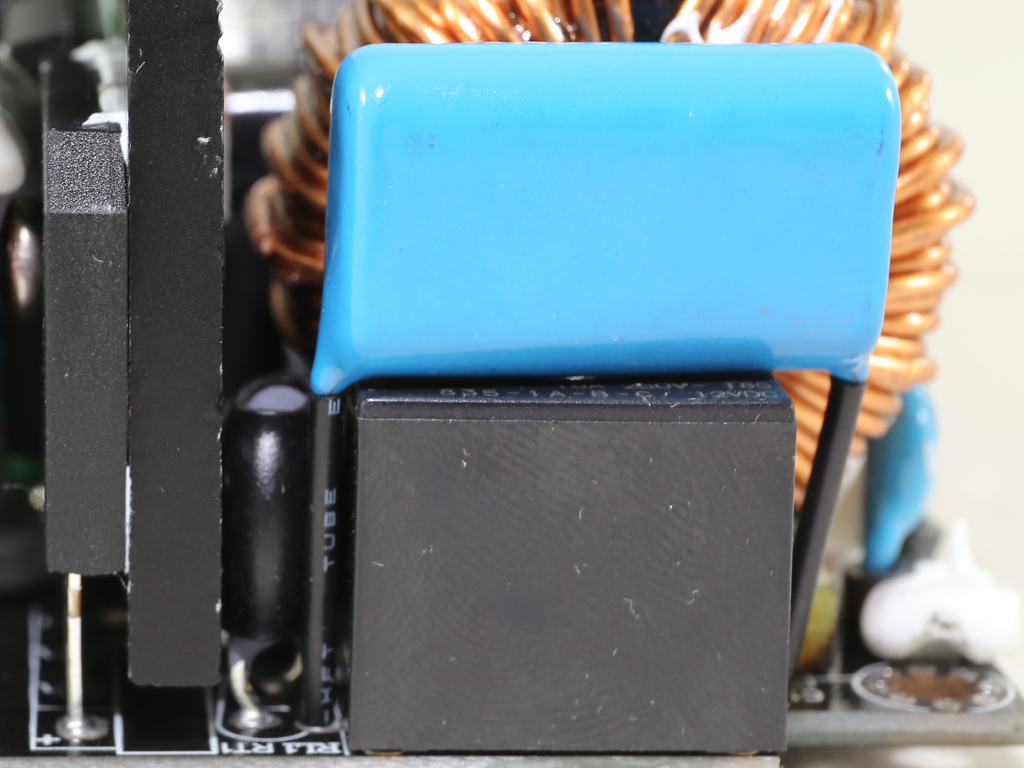Corsair SF600 Power Supply Review
We recently evaluated Corsair's SF450, which left a good impression on us. Now it's time to test the family's flagship SF600, which can deliver 150W more power using exactly the same cable configuration.
Why you can trust Tom's Hardware
A Look Inside And Component Analysis
Parts Description
Before proceeding with this page, we strongly encourage you to a look at our PSUs 101 article, which provides valuable information about PSUs and their operation, allowing you to better understand the components we're about to discuss. Our main tools for disassembling PSUs are a Thermaltronics soldering and rework station, and a Hakko 808 desoldering gun.
| Primary Side | |
|---|---|
| Transient Filter | 4x Y caps, 2x X caps, 3x CM chokes, 1x MOV |
| Inrush Protection | NTC Thermistor & Relay |
| Bridge Rectifier(s) | 1x GBU1508 (600V, 15A @ 115 °C) |
| APFC MOSFETs | 1x Alpha & Omega AOK42S60 (700V, 25A @ 100 °C, 0.099 ohm) |
| APFC Boost Diode | 1x CREE C3D06060A (600V, 9A @ 135 °C) |
| Hold-up Cap(s) | 1x Nippon Chemi-Con (420V, 470uF, 2000h @ 105 °C, KMZ) |
| Main Switchers | 2x Fairchild FCP104N60F (600V, 24A @ 100 °C, 104 mohm) |
| APFC Controller | Champion CM6502S & CM03X Green PFC controller |
| Switching Controller | Champion CM6901 |
| Topology | Primary side: Half-Bridge & LLC Resonant Converter Secondary side: Synchronous Rectification & DC-DC converters |
| Secondary Side | |
| +12V MOSFETs | 6x Alpha & Omega AON6590 (40V, 100A @ 100 °C, 1.55 mohm @ 125 °C) |
| 5V & 3.3V | DC-DC Converters: 4x Infineon BSZ040N04LS G (40V, 40A @ 100 °C, 4 mohm) PWM Controller: APW7159 |
| Filtering Capacitors | Electrolytics: Nippon Chemi-Con (KZE, KMG), Rubycon (105 °C) Polymers: Nippon Chemi-Con, FPCAP, CapXon (DC-DC converters) |
| Supervisor IC | SITI PS229 (OVP, UVP, OCP, PG) & AS358M |
| Fan Model | Corsair NR092L (92mm, 12V, 0.22A, 3950 RPM, rifle bearing) |
| 5VSB Circuit | |
| Rectifier | 1x APS04N60H FET (620V, 2.2A @ 100 °C) 2x SVM1045V (45V, 10A @ 25 °C) |
| Standby PWM Controller | Leadtrend LD7750RGR |





Both SF models are made by Great Wall, the same manufacturer that also makes Corsair's CS series. Naturally, the SF600's platform shares many common parts with the SF450. The only differences on the primary side are a stronger boost diode and larger bulk cap in the APFC converter. Two additional FETs are used for +12V regulation, too. The cooling fan is the same, however its profile is much more aggressive in the SF600 to cope with increased thermal load. Although the max power output is very high for an SFX unit, the double-sided PCB isn't overcrowded by components. Installing many components (including the +12V FETs) on the PCB's solder side plays a major role in this.





A small PCB right behind the AC receptacle holds the first part of the EMI filter, which includes two Y caps, one X cap and a CM choke. The second part of the EMI filter is on the main PCB; it consists of two Y caps, a single X cap, two CM chokes and an MOV.
There is an NTC thermistor for protecting against large inrush currents. It is supported by a bypass relay, which allows for its fast cool-down.


The bridge rectifier (GBU1508) is installed on the primary heat sink. It is strong enough to meet this PSU's needs.





The APFC converter uses only one FET, an Alpha & Omega AOK42S60, along with a CREE C3D06060A boost diode. The bulk cap is provided by Chemi-Con (420V, 470uF each, 2000h @ 105 °C, KMZ), and although its capacity looks low, it still offers a high-enough hold-up time to exceed the ATX spec's threshold.


The APFC controller is a Champion CM6502S, which is also supported by a CM03X Green PFC controller that reduces power consumption at standby. Both ICs are installed on the mainboard's solder side.
Get Tom's Hardware's best news and in-depth reviews, straight to your inbox.



The main switching FETs are two Fairchild FCP104N60Fs arranged into a half-bridge topology. An LLC resonant converter is used to increase efficiency. The resonant controller is a Champion CM6901, and it's installed on the solder side of the mainboard. An isolated driver is also used by the primary FETs, supporting switching frequencies of up to 8MHz. Its model number is Si8233BD.
The image above is a simplified schematic of a half-bridge topology featuring an LLC resonant converter. The Cr capacitor, along with the Ls and Lp inductors, form the LLC tank circuit.



Six Alpha & Omega AON6590 FETs installed on the PCB's solder side rectify the +12V rail. Each one can handle up to 100A at 100 °C. Four polymer caps provided by FPCAP filter this rail. On the secondary side, we found a small Chemi-Con KMG electrolytic cap. Three more electrolytic caps, a single Rubycon and two Chemi-Cons, all rated at 105 °C, are installed close to the 5VSB rail's transformer.



The minor rails are handled by a couple of DC-DC converters installed on a vertical daughterboard. Both converters use four Infineon BSZ040N04LS G FETs and the common PWM controller is an ANPEC APW7159. Filtering is performed by several CapXon polymer caps. Many of you will be disappointed by the manufacturer of choice. But remember that we're talking about polymer caps and not electrolytic ones, so there's nothing to worry about. Polymer caps last a long time even under tough conditions.



There are two SVM1045V SBRs close to the 5VSB transformer, and on the PCB's solder side we find a APS04N60H FET and the standby PWM controller, a Leadtrend LD7750RGR.






On the front side of the modular PCB, a large number of Chemi-Con polymer capacitors are used for filtering the PSU's outputs. The solder side of this board hosts a lot of SMD ceramic caps.




The SF600's soldering quality is very good, and we notice a lot of interesting parts on the pictured side of its PCB, including the supervisor IC, a SITI PS229 (OVP, UVP, OCP, PG), along with a AS358M op-amp. In fact, there are two AS358Ms, though only one is likely used by the unit's protection circuit.


The 92mm rifle bearing fan can push lots of air at full speed. Its model number is NR092L, and according to Corsair its blades increase airflow while minimizing noise as much as possible. A semi-passive mode (Zero RPM, as Corsair calls it) keeps the fan from spinning under light loads. However, under taxing situations, the fan makes its presence known with an aggressive profile. In our opinion, there is no need for this at up to around 450W.
Current page: A Look Inside And Component Analysis
Prev Page Packaging, Contents, Exterior And Cabling Next Page Load Regulation, Hold-Up Time And Inrush Current
Aris Mpitziopoulos is a contributing editor at Tom's Hardware, covering PSUs.
-
dudmont Are these small SFX designed for systems with ITX boards? I understand your complaints about the 8 pin cpu cables, but your complaints about PCIe cables doesn't make sense in light of the fact that no ITX board can handle more than one card. If you're using a micro-atx board, you can use a standard size PSU.Reply -
powernod Wait a moment. Only 2 pci-e cables with 1 connector each one? That means that only one high-end GPU can be supported.Reply
Just like Aris said, what is the reason to go from the SF450 to the SF600, if you can't put another GPU?
+150 watts only to feed SATA devices???!! -
LePhuronn ReplyA 600W PSU can drive a couple of high-end graphics cards and an overclocked CPU. But with only two PCIe connectors, the SF600 natively supports just one enthusiast-class GPU
Yeah, because this PSU is intended to power top-end Mini ITX systems which can only run a single GPU. I thought that was obvious, or is there some standard requirement to review a component entirely in isolation without considering its application? -
LePhuronn ReplyWait a moment. Only 2 pci-e cables with 1 connector each one? That means that only one high-end GPU can be supported.
Just like Aris said, what is the reason to go from the SF450 to the SF600, if you can't put another GPU?
+150 watts only to feed SATA devices???!!
Headroom. I'm current running an original Titan and i5 2500 on Silverstone's ST45-G modualr PSU, and I'm only overclocking the Titan. However, I'm moving the Titan to a new build with a i7 6700K and I don't feel too comfortable pushing both the CPU and the GPU as far as they'd go with only 450W. I'd have no worries with a 600W. -
g-unit1111 Reply17905577 said:Are these small SFX designed for systems with ITX boards? I understand your complaints about the 8 pin cpu cables, but your complaints about PCIe cables doesn't make sense in light of the fact that no ITX board can handle more than one card. If you're using a micro-atx board, you can use a standard size PSU.
Yes. They're designed to work in ultra compact cases like the Silverstone Raven RVZ01B, RVZ02B, as well as the Fractal Design Node 202. I think Corsair is even releasing their own ultra compact case at some point. But the trend is that cases are getting smaller, not bigger. Sure there will always be a market for ATX and EATX, but with Steam Box, you will start to see more of a demand for this type of case. With each generation from here on out, you'll see single cards be just as powerful as a dual card system. So you can get by with no SLI. -
turkey3_scratch Great Wall really is great. It's incredible that this compact unit blows most 600W units out of the water. It's not so much as "headroom" but if you take this PSU vs the SF450, and put that PSU on a machine with the same load, which will have the lower ripple and tighter voltage regulation? The SF600.Reply -
jimmysmitty Reply17905717 said:Wait a moment. Only 2 pci-e cables with 1 connector each one? That means that only one high-end GPU can be supported.
Just like Aris said, what is the reason to go from the SF450 to the SF600, if you can't put another GPU?
+150 watts only to feed SATA devices???!!
A 980Ti is recommended, by nVidia, to have a 600W PSU and that is for the stock 1000MHz speed 980Ti. If we consider the fact that the majority of 980Tis come stock with 10-20% overclocks then a 600W SF PSU would be preferable for a high end ITX build. I can tell you a lot of people throw 980Tis into ITX builds. -
turkey3_scratch Also let's not forget peak efficiency at 50% of a power supply's capabilities, so the SF600 is ideal for that.Reply -
RedJaron Peak efficiency may be around 50% load, but you're forgetting that this is an 80 Gold unit. While it's at least 90% efficient at 50% load ( the graphs looks to be a bit above that ), it's still ( at least ) 87% efficient at 90% load. You're only losing about 5% efficiency between the two here. That only means it draws a few more watts from the wall. Delivery inside the case remains unchanged.Reply
GPU mfrs' recommended PSU capacities are always inflated to compensate for the mediocre ( or worse ) PSUs that flood the mainstream and OEM space. A 980 Ti will pull at most 250W - 275W, depending on OC, during a heavy gaming load. Torture tests can go above 300W, but no one mines with an ITX box. Adding the 130W you'll see from the rest of a typical i7 system, you'd rarely see this go above 400W. That's an 88% load on a 450W PSU. Tight, but certainly not risky or dangerous. As I constantly remind people, my i7 + 290X test bed runs just fine on a 500W PSU, and that GPU is a lot hungrier than the 980 Ti.
The only legitimate use for this PSU, with it's 600W but very limited cables, that I can think of is a heavily OC'd ITX gaming box built in a case that requires an SFX PSU. I can't find a single Z170 or X99 ITX board that has more than an 8-pin CPU power connector, so the PSU's limitation there shouldn't matter. Split the load 300W for the GPU, 250W for the CPU and rest of the system and you duck in just under the power limit. But again, that only makes sense if you MUST use a SFX PSU. Plenty of small cases support full size ATX units, where you have a lot more selection.
This feels as though either Corsair is trying to fleece some customers into spending more than necessary or they got lazy in expanding a product line by increasing capacity without also taking the trouble to re-tool the cabling. -
Aris_Mp In my opinion a 600W PSU (even an SFX one) should have 4x PCIe connectors, because VGAs like the GTX970 and GTX980 consume 160W-200W at worst case scenario, so a couple of them can be easily supported.Reply

